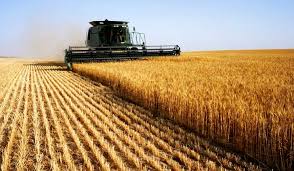
Bakery Operators Lament As Wheat Production Crashes By 89.4%
Local wheat production has fallen by 89.4 per cent, raising concerns by bakery operators over the rising cost of production.
Wheat production in Nigeria has crashed by 89.44 per cent, dropping from about 350,000 metric tonnes annually to as low as 36,943.8MT, the Federal Government has said.
Data from the latest report of Wheat Production Survey in Nigeria 2021, which was obtained from the National Bureau of Statistics, showed that the 36,943.8MT was produced in 13 states.
In November 2021, it was reported that the national production of wheat had been around 350,000MT since 2017, according to a report from the Federal Ministry of Agriculture and Rural Development.
The FMARD had disclosed this in its report on Recommended Strategies to Improve Wheat Value Chain in Nigeria, presented at the 2021 Wheat Stakeholders Workshop.
But the NBS in its Wheat Production Survey in Nigeria 2021, seen in Abuja on Sunday, put the amount of wheat produced in 13 states across the country at 36,943.8MT.
Industry operators told our correspondent that the rise in the cost of bread and pastries, triggered by the hike in flour price, was due to the low domestic production and high imports of wheat, a major raw material for flour used in baking.
The NBS, however, stated that wheat farming was experiencing renewed interest from policymakers who saw Nigeria’s potential to be self-sufficient in wheat production.
“But as vital as wheat is, we cannot say with certainty the actual quantity of wheat produced in the country as conflicting figures were being published from different sources,” the bureau stated.
It added, “There has been no recent survey or study to estimate the wheat production in Nigeria. The last official estimate of the wheat acreage is 60,000 hectares and dates back to 2008.
“Much has changed since then, and this study provided an overview of the current wheat production in Nigeria. The wheat production survey was conducted across 13 states in Nigeria covering 2020/2021 farming season by the NBS.”
The bureau analysed wheat production in 13 northern states and concluded that the crop was cultivated in an area of about 11,820 hectares with production of 36,943.8MT of grain across the identified states.
It outlined the states to include Kano, Jigawa, Kebbi, Bauchi, Kaduna, Gombe, Yobe, Katsina, Plateau, Sokoto, Zamfara, Borno and Adamawa.
It said the maximum area under wheat cultivation was in Kano (19.68 per cent), followed by Jigawa (17.69 per cent), while Zamfara accounted for the least (1.62 per cent).
Similarly, state wise comparison of wheat production for 2021 showed that Kano was the major producer of wheat, with a production of 6,512.8MT; followed by Jigawa, 5,854.8MT; Kebbi, 4,422MT; while Zamfara ranked last with 672MT.
However, in terms of average yield per hectare, the major wheat-growing states was low compared to other states, as Plateau State recorded the maximum yield of 3.8 tonnes/hectare.
It was followed by Gombe (3.7 tonnes/hectare), while Kaduna had the least (2.7 tonnes/hectare), followed by Kano and Jigawa states with 2.8 tonnes per hectare each.
Economic Confidential had also reported in November that wheat imports into Nigeria were higher than the local production of the commodity by about 1,042.86 per cent, based on data from the FMARD report.
The report had indicated that since independence, Nigeria’s wheat imports had consistently exceeded local production, as the consumption of the product had also continued to rise.
Insecurity, Skill Deficiency Worsen Wheat Production, Say Farmers
Reacting to the development, the All Farmers Association of Nigeria, said many wheat farmers were no longer going to their farms due to insecurity, as the crop was basically cultivated in the North.
They said the lack of skilled farmers and climate change also contributed to the plunge in wheat production in Nigeria in 2021.
Speaking on behalf of farmers, the National Vice President, AFAN, Chief Daniel Okafor, told our correspondent that the situation might not improve if insecurity and other concerns in the sector were not addressed.
He said, “What happened last year which affected wheat production, was a general issue in Nigeria, as it also affected other crops. However, in Nigeria, only a few states cultivate wheat.
“Climate change is one factor that impacted adversely on crop production in 2021. That is the first thing I know that affected production and it affected wheat adversely.
“Another thing is that the ministry of agriculture is not helping matters with the way and manner they promote the production of crops. They have to change the way they deal with various crop associations and farmers.”
He added, “They should give farmers the required training, particularly for special crops like wheat. This will ensure that farmers carry out good agricultural practices in wheat production and it will definitely help in boosting our various outputs.”
On insecurity, Okafor said, “Another thing is that farmers are not going to their farms again and this is a problem to the country. This is because of the spat of kidnappings and other crimes across the country.”
He stated that the use of wheat in confectioneries in Nigeria was high, adding that this was why the imports of the commodity had been on the rise over the years.
The FMARD report had shown that in the 1960s, 1970s, 1980s and 1990s, wheat production domestically were around 5,700MT, 65,000MT, 50,000MT and 170,000MT, respectively, while imports were 148,000MT, 194,000MT, 680,400MT and 1.1 million MT, respectively.
Domestic consumption during the periods was put at 144,000MT, 191,000MT, 686,000MT and 1.115 million MT, respectively.
The report had also stated that in the 2000s and 2010s, national production levels dropped to 50,000MT and 70,000MT respectively, with consumption levels of 883,000MT and 3.41 million MT respectively, and imports were 861,200MT and 3.316 million MT respectively.
The ministry had further explained that wheat consumption had been on the rise in Nigeria due to population growth, changing food preferences and strong urbanisation trend.
According to the FMARD, the challenges to local production include low level of mechanisation, biotic and abiotic stress such as pests and diseases, low soil fertility and lack of adequate technology.
Bread producers have, however, said the latest crash in local wheat production would further mar the fortunes of their businesses.
According to the President, Premium Bread-makers Association of Nigeria, Emmanuel Onuorah, members have been importing wheat for a long time due to low local production.
He said lack of forex scarcity had worsened the plight of bread producers.
He said, “We consume about 4.7 million metric tonnes of wheat every year. Nigeria produces less than 200,000 MT out of the 4.6 million MT. The quantity of wheat that we produce in Nigeria has never been more than 300,000 MT in one year. Our annual requirement is close to five million MT now but Nigeria does not produce up to 300, 000 of that. We’ve never been able to produce what we need for a day’s production annually.”
“What is causing the problem right now is that China is buying up all the wheat. Nobody knows what they are doing with it. Then our own situation is very precarious because of the FX volatility. The foreign exchange volatility is not helping because millers will have to source their foreign exchange from the black market, the Federal Government does not even give them up to five per cent of their FX component to import wheat from North America or wherever they get it from.”
“Nigeria wheat production does not affect price of bread in any way. We import the bulk of our wheat from Canada, United States, parts of Brazil and Australia. The cause of the increasing price (of bread) is because the Federal Government is charging 30 per cent on wheat importation. There is a 15 per cent wheat development levy that the government has not removed and it is still charging for other things at the ports.”
